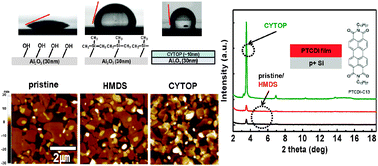We report on the fabrication of N,N′-ditridecyl-perylene-3,4:9,10-tetracarboxylic diimide–C13 (PTCDI–C13), n-channel organic thin-film transistors (OTFTs) with 30 nm Al2O3 whose surface has been un-modified or modified with hexamethyldisilazane (HMDS) and thin hydrophobic CYTOP. Among all the devices, the OTFTs with CYTOP-modified dielectrics exhibit the most superior device performance and stability. The optimum post-annealing temperature for organic n-channels on CYTOP was also found to be as low as 80 °C, although the post-annealing was previously implemented at 120–140 °C for PTCDI domain growth in general. The low temperature of 80 °C hardly damages the CYTOP/n-channel organic interface which is deformed at a temperature higher than the glass transition temperature of CYTOP (∼110 °C). The pentacenequinone passivation layer turned out to be helpful to keep the interfacial trap density minimum, according to the photo-excited charge collection spectroscopy results for our 80 °C-annealed OTFTs with CYTOP-modified dielectrics.

You have access to this article
 Please wait while we load your content...
Something went wrong. Try again?
Please wait while we load your content...
Something went wrong. Try again?


 Please wait while we load your content...
Please wait while we load your content...